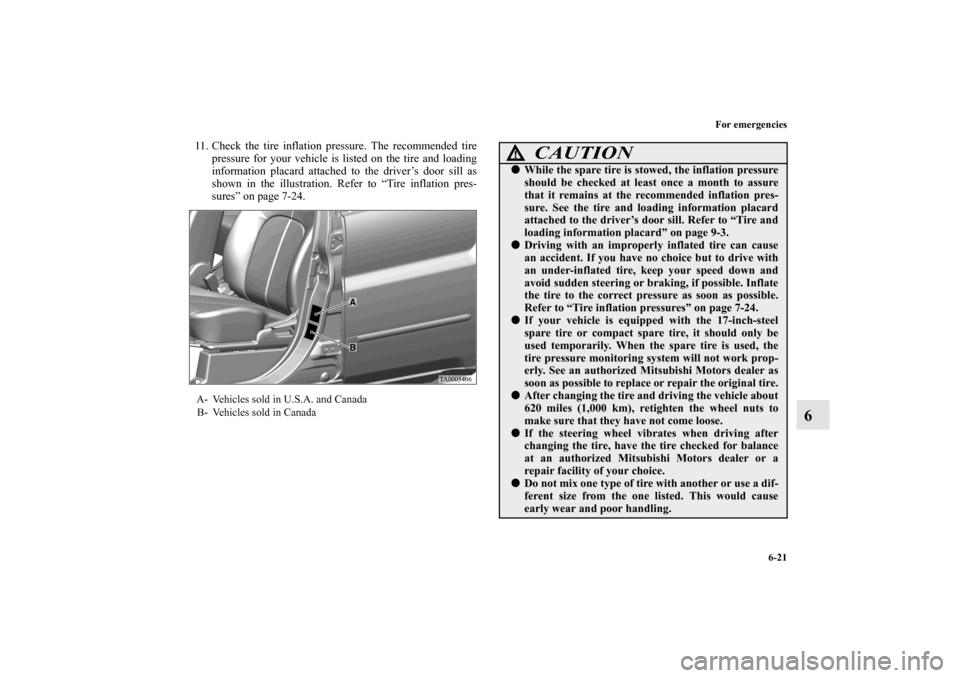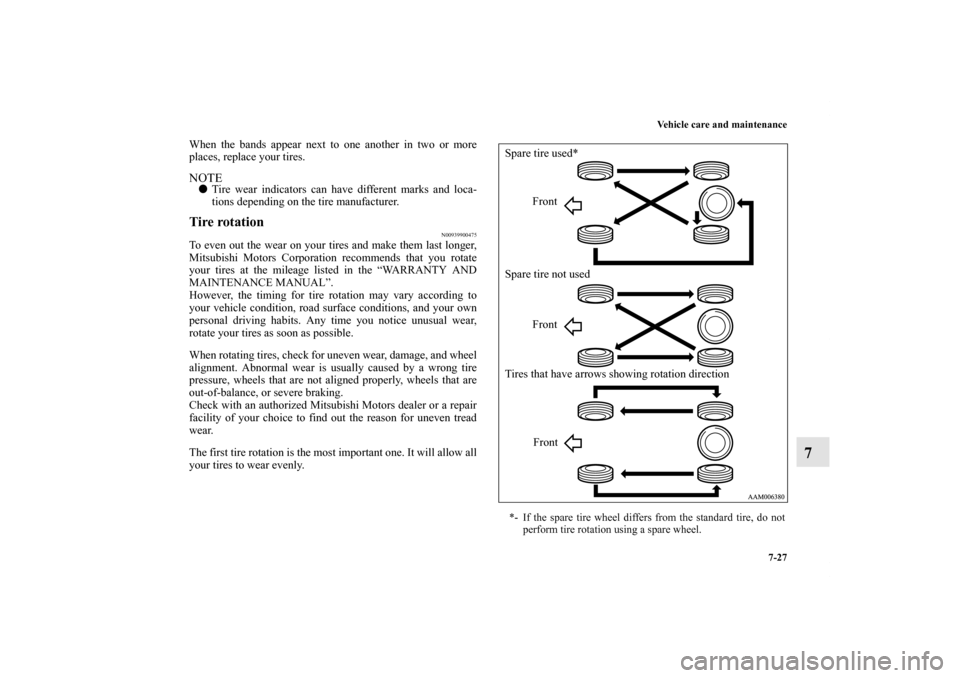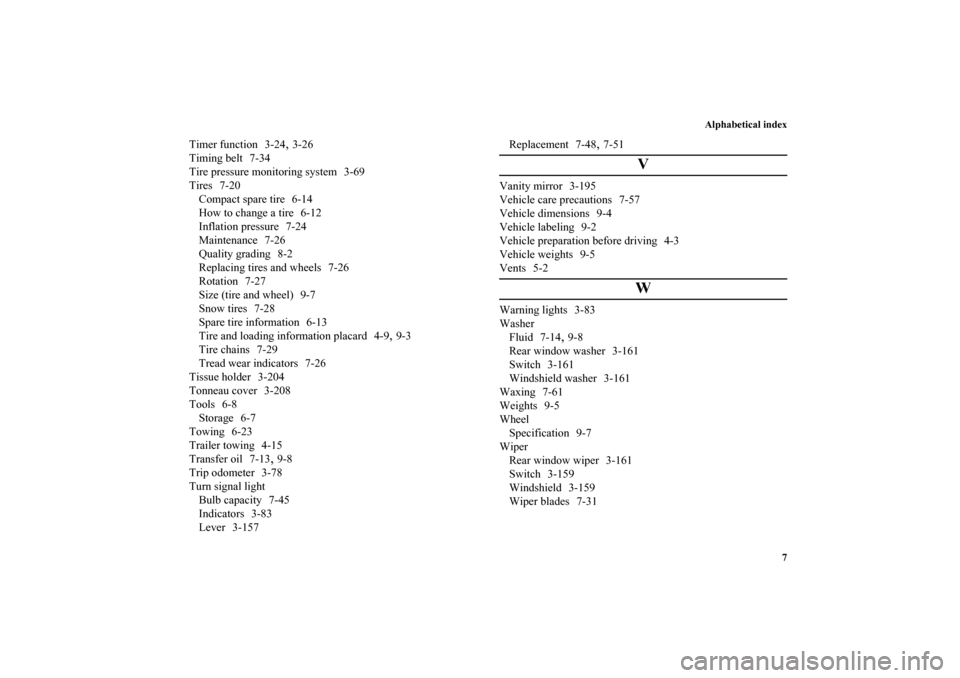Page 417 of 514
6-18 For emergencies
6
6. Clean out any mud, etc. on the hub surface (F), hub bolts
(G) or in the installation holes (H) in the wheel, and then
mount the spare tire.
WA R N I N G
!�Mount the spare wheel with the valve stem (I) facing
outboard. If you cannot see the valve stem (I), you
have installed the wheel backwards.
Operating the vehicle with the spare wheel installed
backwards can cause vehicle damage and result in
an accident.
BK0102600US.book 18 ページ 2009年3月30日 月曜日 午後2時2分
Page 418 of 514
For emergencies
6-19
6
7. On aluminum wheels, temporarily tighten the wheel nuts
(flange nuts) until their flange section comes in contact
with the wheel and it is no longer loose.On steel wheel (spare wheel), install the wheel nuts with
their tapered ends facing inward, then tighten by hand
until the wheel is no longer loose.
NOTE�Flange nuts can be temporarily used on the steel wheel
(spare wheel), but return them to the original wheel and
tire as soon as possible.
�If all four wheels are changed to steel wheels, use tapered
nuts.
Aluminum wheels
CAUTION
!�Never apply oil to either the wheel bolts or the nuts
or they will tighten too much.Steel wheel (spare wheel)
BK0102600US.book 19 ページ 2009年3月30日 月曜日 午後2時2分
Page 420 of 514

For emergencies
6-21
6
11. Check the tire inflation pressure. The recommended tire
pressure for your vehicle is listed on the tire and loading
information placard attached to the driver’s door sill as
shown in the illustration. Refer to “Tire inflation pres-
sures” on page 7-24.A- Vehicles sold in U.S.A. and Canada
B- Vehicles sold in Canada
CAUTION
!�While the spare tire is stowed, the inflation pressure
should be checked at least once a month to assure
that it remains at the recommended inflation pres-
sure. See the tire and loading information placard
attached to the driver’s door sill. Refer to “Tire and
loading information placard” on page 9-3.�Driving with an improperly inflated tire can cause
an accident. If you have no choice but to drive with
an under-inflated tire, keep your speed down and
avoid sudden steering or braking, if possible. Inflate
the tire to the correct pressure as soon as possible.
Refer to “Tire inflation pressures” on page 7-24.�If your vehicle is equipped with the 17-inch-steel
spare tire or compact spare tire, it should only be
used temporarily. When the spare tire is used, the
tire pressure monitoring system will not work prop-
erly. See an authorized Mitsubishi Motors dealer as
soon as possible to replace or repair the original tire.�After changing the tire and driving the vehicle about
620 miles (1,000 km), retighten the wheel nuts to
make sure that they have not come loose.�If the steering wheel vibrates when driving after
changing the tire, have the tire checked for balance
at an authorized Mitsubishi Motors dealer or a
repair facility of your choice.�Do not mix one type of tire with another or use a dif-
ferent size from the one listed. This would cause
early wear and poor handling.
BK0102600US.book 21 ページ 2009年3月30日 月曜日 午後2時2分
Page 421 of 514
6-22 For emergencies
6
To install the flat tire or spare tire
N00849900057
Tighten the clamp (A) firmly with your fingers by turning it
clockwise until the tire cannot move.
To store the jack, bar and wheel nut wrench
N00850000029
Reverse the removing procedure when storing the jack, bar and
wheel nut wrench.
Refer to “Tools and jack” on page 6-7.
BK0102600US.book 22 ページ 2009年3月30日 月曜日 午後2時2分
Page 454 of 514

Vehicle care and maintenance
7-27
7
When the bands appear next to one another in two or more
places, replace your tires. NOTE�Tire wear indicators can have different marks and loca-
tions depending on the tire manufacturer.Tire rotation
N00939900475
To even out the wear on your tires and make them last longer,
Mitsubishi Motors Corporation recommends that you rotate
your tires at the mileage listed in the “WARRANTY AND
MAINTENANCE MANUAL”.
However, the timing for tire rotation may vary according to
your vehicle condition, road surface conditions, and your own
personal driving habits. Any time you notice unusual wear,
rotate your tires as soon as possible.
When rotating tires, check for uneven wear, damage, and wheel
alignment. Abnormal wear is usually caused by a wrong tire
pressure, wheels that are not aligned properly, wheels that are
out-of-balance, or severe braking.
Check with an authorized Mitsubishi Motors dealer or a repair
facility of your choice to find out the reason for uneven tread
wear.
The first tire rotation is the most important one. It will allow all
your tires to wear evenly.
*- If the spare tire wheel differs from the standard tire, do not
perform tire rotation using a spare wheel.Spare tire used*
Front
Spare tire not used
Front
Tires that have arrows showing rotation direction
Front
BK0102600US.book 27 ページ 2009年3月30日 月曜日 午後2時2分
Page 455 of 514

7-28 Vehicle care and maintenance
7
Snow tires
N00940000405
In some areas of the country, snow tires are required for winter
driving. If snow tires are required in your area, you must
choose snow tires of the same size and type as the original tires
provided with your vehicle. Snow tires should also be installed
on all four wheels. Otherwise your safety and vehicle handling
can be reduced.
Even where laws may permit it, snow tires should not be oper-
ated at sustained speeds over 75 mph (120 km/h).
CAUTION
!�A compact spare tire can be fitted temporarily in
place of a tire that has been removed during the tire
rotation. However, it must not be included in the
regular tire rotation sequence.�If the tires have arrows (A) indicating the correct
direction of rotation, swap the front and rear tires
on the left-hand side of the vehicle and the front and
rear tires on the right-hand side of the vehicle sepa-
rately. Keep each tire on its original side of the vehi-
cle. When installing the tires, make sure the arrows
point in the direction in which the wheels will turn
when the vehicle moves forward. Any tire whose
arrow points in the wrong direction will not perform
to its full potential.
Front
CAUTION
!�Avoid the combined use of different types of tires.
Using different types of tires can affect vehicle per-
formance and safety.
CAUTION
!�As your vehicle is equipped with a tire pressure
monitoring system, use only Mitsubishi genuine
wheels.
Other wheels do not permit correct installation of
tire inflation pressure sensors and can thus cause air
leakage and sensor failure, which would not be cov-
ered by your vehicle’s warranty.
See an authorized Mitsubishi Motors dealer when
you replace a tire or wheel.
BK0102600US.book 28 ページ 2009年3月30日 月曜日 午後2時2分
Page 512 of 514

Alphabetical index
7
Timer function 3-24
,3-26
Timing belt 7-34
Tire pressure monitoring system 3-69
Tires 7-20
Compact spare tire 6-14
How to change a tire 6-12
Inflation pressure 7-24
Maintenance 7-26
Quality grading 8-2
Replacing tires and wheels 7-26
Rotation 7-27
Size (tire and wheel) 9-7
Snow tires 7-28
Spare tire information 6-13
Tire and loading information placard 4-9
,9-3
Tire chains 7-29
Tread wear indicators 7-26
Tissue holder 3-204
Tonneau cover 3-208
Tools 6-8
Storage 6-7
Towing 6-23
Trailer towing 4-15
Transfer oil 7-13
,9-8
Trip odometer 3-78
Turn signal light
Bulb capacity 7-45
Indicators 3-83
Lever 3-157Replacement 7-48
,7-51
V
Vanity mirror 3-195
Vehicle care precautions 7-57
Vehicle dimensions 9-4
Vehicle labeling 9-2
Vehicle preparation before driving 4-3
Vehicle weights 9-5
Vents 5-2
W
Warning lights 3-83
Washer
Fluid 7-14
,9-8
Rear window washer 3-161
Switch 3-161
Windshield washer 3-161
Waxing 7-61
Weights 9-5
Wheel
Specification 9-7
Wiper
Rear window wiper 3-161
Switch 3-159
Windshield 3-159
Wiper blades 7-31
BK0102600US.book 7 ページ 2009年3月30日 月曜日 午後2時2分